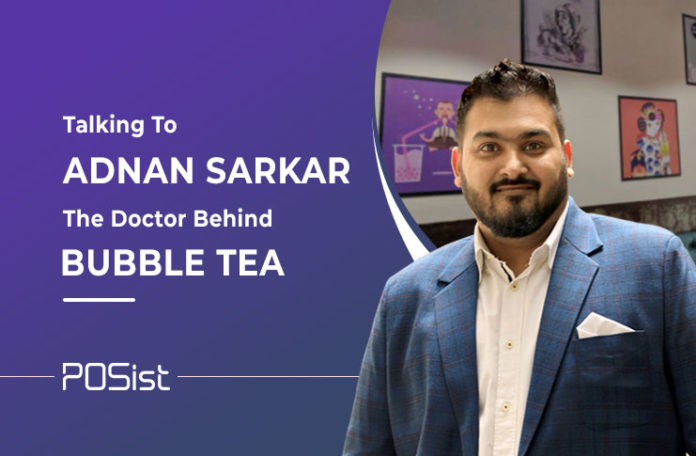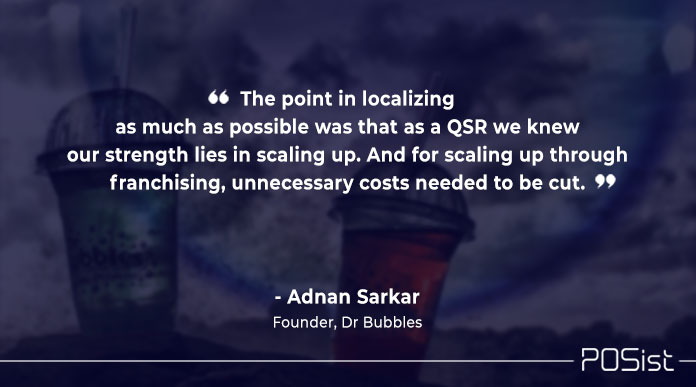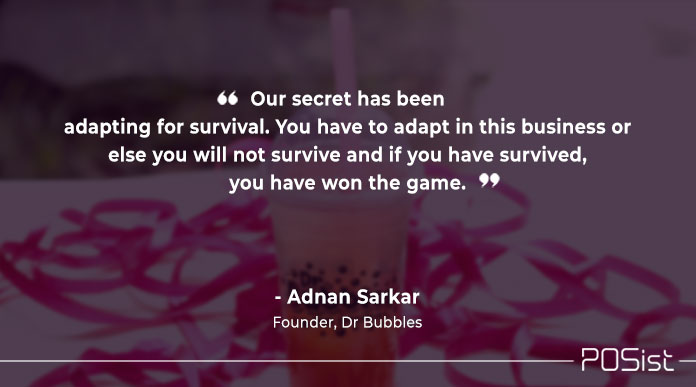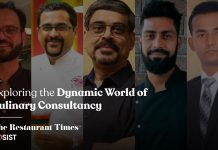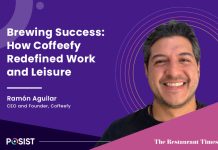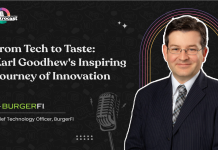A man who loves innovation and a concept that sounds unreal in itself. Such is the combination of Adnan Sarkar and Bubble Tea, leading to the creation of India’s own next big beverage brand- Dr Bubbles. Already a phenomenon abroad, Sarkar stumbled upon Bubble Tea in one of his travels and then there was no looking back. He did not introduce the concept to India, but he definitely Indianized the concept to discover a new potential beverage snuck away in corners of familiarity. This is how it all happened.
The Tale Of Dr Bubbles
Originating in Taiwan, Bubble Tea had already hit the world by the time Sarkar found it. India had seen this trend as well but being a testy market, the tea failed to impress Indian palates and was soon out. Dr Bubbles came on the scene when the original Bubble Tea was being rejected by the Indian audience. To understand how it changed the market and the product itself, we talked to Adnan Sarkar, the founder of Dr Bubbles.
What changes were made in the original bubble tea to make it more suitable for the Indian palate?
Bubble tea originally is black iced tea or milk iced tea in which black tapioca balls are mixed. While Indianizing the product we retained this idea of Bubble Tea, in a sense the essence of Bubble Tea but changed everything else. The thing about Indian palate is that it is selective about newer innovations and so, prefers a similar taste. All our concepts and creation in Dr Bubbles revolve around this understanding. If we say we have something new, 75% people will run away with the thought that “I would rather have something safe.” We are giving them that safety with additions to it. When you think about it, tapioca is just ‘Black Sabudana’ so it is tasteless for Indian taste buds but then when you introduce it with things like popping bubbles, jellies, chocolate chips, the idea of Bubble Tea for India is remade but the concept of Bubble Tea which is putting things in your drink stays.
What is your USP? Is it the flavour of Bubble Tea, the concept, or the health benefit it comes with it?
The thing with Bubble Tea is that it needs to be perfect for the consumer. Everyone has a different taste and because of that pre-set choices don’t work. Our ‘Do-It-Yourself’ style of making tea is our USP. We don’t tell our customers till their 3rd or 4th visit about the health properties of tea because we want it to sell on its taste combinations and funkiness. We let the customer choose their base, their flavours and what all they want in their Tea, everything is custom made for that consumer. Honestly, there are a number of products in my head even today which we cannot launch because they go too far from the concept of Bubble Tea.
We have a checklist which if a product matches with, we run a test in all our stores for. We do not launch the product directly as it may never work. At least in India, I feel you need to give the product to the masses and let the audience decide.
Dr Bubbles did not just invent its product but the machines they come out of as well. Why not just go for standard industry machines?
We always wanted to build the brand for franchising and when you know that you have to scale at such a level and how to do it, you need to make sure that it is feasible on the pocket. You cannot get a machine from outside and expect your franchise to pay for it. Initially, we had these imported machines but then we started localizing every machine in India. This led to the invention of machines that were custom made for our needs. For example, we have the machine in which tea is kept at a standard temperature and it stays warm without burning or getting acidic. If you keep tea at a constant temperature of 60 degrees then this happens. This level of innovation came only through the localization of our equipment which was far cheaper than investing in pre-made equipment that would not listen to us.
Even this localization was a challenge. Most people just told me that the types of machines I want are impossible to get. We even went to one of the biggest players in South to hear the same answer. Ultimately one company agreed and what I gave them was a basic sketch of what I want the machine to do. They said that it was not a problem provided we gave them a quantity. The minimum order quantity for that machine was 250 units and I did it because everything that we have done is to scale up. Honestly, we only need one machine per unit but we have 250 because that is the target.
Then coming to the sealing machines. Our concept is that we seal each glass and then give it to the customer. Firstly because it is far more convenient and practical and secondly because it is super cheap. As compared to popular international or even Indian alternatives which cost about 60 paise, sealing a glass costs us about 2 paise. The machinery for that, however, was approximately 1 lakh a unit. Here once again we went on to localize the equipment. We went to another manufacturer, gave him the liberty to remove anything that needed to be removed given that the end product was matched and now to every franchise, we sell that localized machine for hardly 15,000 Rupees. This is a machine that will perform the same way and do the same function as an international machine worth 1 lakh.
Apart from acceptability, what challenges did you face before you opened the doors of Dr Bubbles?
Understanding the market and getting the right staff was a huge challenge. To solve this I did a bit of an experiment. Dr Bubbles opened three stores in Mumbai, all in different market environments. One was in a mall, another in a market locally termed as ‘Khaou Galli’ and the last in a high street. My aim was to study the market for a year but when we came to the results, all of them were different and each one helped me grow.
The mall had an only weekend business. On the other hand, the crowd in a mall is mostly the rich, well-travelled lot so selling bubble tea in the mall was not a challenge. On high street, we only had day crowd. Our sales depended on the timings of the shops around us. In the Khaou Galli, there was just an evening crowd. The point was that we realized that where ever we go we will have to tweak our strategy to get people to the store. In the mall, it was about the offers, on the high street about the location and visibility and regardless of the area, about the good staff.
When it comes to our staff, we have never emphasized the qualifications or even education but on a strong and attractive personality. In Dr Bubbles, we don’t care what language the staff talks in as long as they are confident in selling the product. For us, a person who can confidently communicate and explain the product takes 90% of the strain away from the brand. In the end, we realized for us the main challenge is to get the right staff, people who can not only make our customers understand the product but actually guide them to the best combination of it. In the cafe business, the staff has certain ideas already ingrained in their heads. We are totally different from what they are used to in a cafe environment, so making them forget everything and then relearn the process our way was the biggest challenge there was.
Why did you hire bartenders and not baristas for Dr Bubbles?
I hired bartenders because, at the end of the day, Bubble tea is exactly like a cocktail without alcohol. We do not use any mixer grinders in the kitchen, we still only use cocktail shakers. Milkshake is supposed to be shaken, not blended. When you blend it all the flavours mix, create a different taste and the properties just blend together. So to get the shake right I had to hire bartenders only. The only thing that differentiates this from a cocktail is the lack of alcohol. Also initially we could not ask a fresher to do this.
Now we have a machine that does this for us. Again we got a machine built that replicates a bartender’s hand motion for our brand. What differentiates us majorly is the process with which we remake our drinks and how we employ technology for it, for example, we make milkshakes only by shaking it in an elliptic motion, not even up and down because that is how you can get best properties out of your milkshake.
We never use baristas for this because we always wanted this to be a QSR and never a cafe. That was just the logic of business for us. My best selling outlet is my smallest outlet and my worst performing outlet is my biggest outlet. The turnaround of this product is 3 minutes, if I turn this space into a cafe I go from a three-minute turn around to a half an hour turn around. We have never even served in anything that promotes sitting at the outlet. Even all our packaging is single-use plastic.
How has the journey been so far and how do you plan to take Dr Bubbles forward?
Personally, for me, I will say the journey is still not complete and is divided into three parts. We started with 3 shops. The first year was getting the concept, the location, the marketing strategy and the business model right.
The second year, which is the second part of our journey was getting our costing right and the backend localized so we can enter the franchise market. Right now we run at a costing of 20% only. On some products, we even have a profit margin of 85%. When we started we were at the costing of 50-60% We reached the 20% level through numbers and scalability. Initially, we were buying everything locally. Then I did a reverse calculation of about 100 outlets. I came onto the figures for a hundred outlets and gave those to my suppliers. I got the manufacturer’s rate from them. The manufacturer’s who could not give me that quantity and price, I started to manufacture their products myself, for example, all the toppings are manufactured in-house. A litre of strawberry crush that cost me 60 rupees if I manufacture it was being sold to me for 180 rupees. That was the basic idea for the second year- to get an amazing costing. The logic is that even if you have an outlet doing the worst sales on the planet, you will still be making money. If other brands make merely 3 lakh a month, they would be in a loss but we are profitable even if we make just that much. In our brand, if we are generating sales of 3 lakh rupees, 1.5 lakh profits are still being made. It is a 50% markup. How we do that is with a 20% margin.
For the third year, our focus was on franchising and we just finished our third year. In about a year we have done 35 franchisees. 12 in Mumbai, 13-14 in Gujarat, one in Delhi, one in Kolkata, One in Hyderabad and Bangalore, now we will go for Chennai. Apart from that, we have outlets in Amravati, Nagpur and Nasik. We are trying to push and grow as much as we can now because all else is set.
Even with so many expansion options, you chose Franchising for Dr Bubbles. Why?
I feel that we are good at one thing but our limiting factor is the location. We are good at this in our specific location. When we franchise Dr Bubbles, we take care of the entire back end but for the front end, having a local person take that up is better for the business. If I go to another area, I will have to invest just that much in publicity and marketing, create a local connection, ask people to come there. If I franchise instead, the issue of local connect and publicity solves itself. The franchise knows the market, the potential customers and the way the brand will work in their city. When you franchise with the right person, it really works very well. I never give a franchise to a basic pure investor, I always give it to people who will be willing to stand behind the counter and then run it. That is our criteria for selection.
As far as handling the backend is concerned, technology is the answer. All our machines are so advanced that they are almost foolproof and very simple to use. The logic is that you make everything so mechanised and so easy that there is no wastage and no process is required. We become a one-stop solution for our franchisees by making all our products mechanised, negating any need for human error. The menu because of this becomes so easy that you could take your office peon and train him to prepare the entire menu in 2 hours. If you have our own machines and raw materials, you can do this. Our idea of supporting the franchise is to make it easy for people who have never worked in this industry. This is like a stepping stone into the hospitality industry.
How do you maintain your brand value and consistency despite Franchising?
We retain control of everything. You can never let the franchise go above you. In the sense that they will have one job that is running the operations of the outlet and sell the product. Apart from that, all the machines are given by us, all the raw materials are given by us, even the software is decided by us. This is the only way or else you will never be able to guarantee quality, taste or the kind of standard that you want to be giving. Every recipe is measurement based, spoon based, there is an SOP for everything and all our recipes are a three-step process. If you make the procedure that simple and don’t put in too many variables, it is very easy to control quality then.
How do you train the staff?
We don’t require skilled people, that has been handled by our machinery already. So we have a central training in Mumbai. For that all franchisees all over India have to send their people over here, we take care of their food, accommodation and training for three days. The first day is basic theory training, the second day is practice and the third day is pressure training. We take them to our best performing outlet and we let them perform under pressure. That is the basic training. For times when a new product is added to the menu, we have franchise meets which happen in every three months because we keep innovating our menu. Next on the tabs is cheese shakes. When these innovations happen, we call all our franchisees to Bombay, make them taste the product ask their review and if we get a 75% positive for it then we go ahead with further refining and launching of the product.
How much profit can a Franchise outlet expect to earn?
That depends on the profits that the outlet makes. I have franchisees doing a 3 lakh a month business and franchisees doing a 15 lakh a month business. Such a vast difference depends on the franchise. We operate at a 40% division so if you are earning 3 lakh a month your share would still be at least one lakh. If you touch 15 lakh rupees, you could take 10 lakh rupees home, that is about 70%
Even the ROI and break even are heavily dependent on the franchise. I have people who have generated their ROI in 2 months, then I also have people who took some 18 months. The investment on the shop by every franchise is 18 lakh. If you earn 1 lakh a month, you will start generating ROI in 18 months, if you earn 10 lakh a month, you will reach there in 2 months. As far as I am concerned, it took me some 2 years to reach break even with Dr Bubbles.


